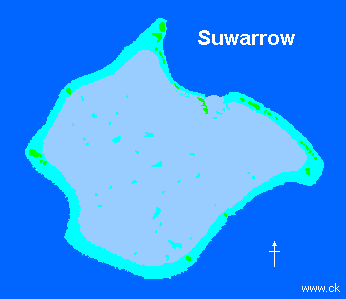Suwarrow - Island of Mystery
 |
AT THE southern extremity of the northern group of the Cook Islands is Suwarrow , a true atoll. There is no continuous history of Polynesian habitation and therefore no traditional Polynesian name for the island. Its first recorded discovery was by a Russian ship, the "Suvorov" on September 17 1814. The crew found the island to be uninhabited. However, Europeans were certainly in residence over the previous several hundred years because Suwarrow is a true treasure island on which chests of coins have been found.
The atoll has one of the best harbors in the Pacific. It is quadrilateral in shape and 50 miles (80 km) in circumference. Its reef encloses a land-locked lagoon 12 miles (19 km) by eight (13 km). Cyclones have often created waves which sweep right over the atoll since its small component of land is extremely low-lying.
Suwarrow has a mysterious past. It was described by Mrs Robert Louis Stevenson as "the most romantic island in the world" . Although it is a tempting thought, it was not the model for "Treasure Island" by her husband Robert Louis Stevenson, since he knew nothing of Suwarrow when he wrote his famous book.
In the mid-19th century a ship out of Tahiti carrying out salvage work on a wreck on Suwarrow's reef unearthed a box containing $15,000 in coins. In 1876 a New Zealander, Henry Mair, discovered silver pieces of eight in a turtle nest. The main find was hastily covered again because of a fracas Mair was involved in and has never yet been rediscovered. An interesting sidelight on Henry Mair is that he was a relative of the well-known New Zealand Maori rights activist of the mid-1990s, Ken Mair. The coins were from 100 years before, during the period when the British navigator, George Anson, crossed the Pacific in 1742 in the HMS "Centurion" after losing five ships in a raid on Spanish shipping in the Pacific.
The main island was once covered with tall forest and banyan trees which were cleared in the mid-1870s when excavations uncovered stone walls and platforms, lime kilns, a flintlock, a musket and a skeleton holding an iron bolt.
Theories abound on the origin of these remains. For more than 250 years Spanish galleons crossed the Pacific from the west coast of the Americas to the Philippines and back again. Most used a more northerly route but it is entirely possible that some of these ships wandered further south and were shipwrecked as a result of the violent storms and cyclones common in these latitudes.
In 1565 the Spanish ship "San Lucas" under the command of Alonso de Arellano, successfully completed the first return trip from Mexico to the Philippines. This epic journey opened the way for the Spanish to develop trade between the two countries and to transport goods overland for onward shipment across the Atlantic to Spain. It says something for the seamanship of the Spaniards that during these 250 years only six ships were completely lost and three were wrecked. A further six European ships are known to have disappeared in the central Pacific between 1526 and 1768.
In the 1950s Suwarrow achieved fame as the home of the New Zealand hermit, Tom Neale, who stayed alone there from 1952 to 1954 and again from 1960 to 1963. His experiences were documented in his book "An Island to Oneself" (see Further Reading). There is also a website which specialises in lauding Tom Neale.
The research vessel Bounty Bay carries visitors from Rarotonga to Suwarrow as part of its Pacific Expeditions venture and specialises in diving, eco-tourism and filming.
Also in Italian